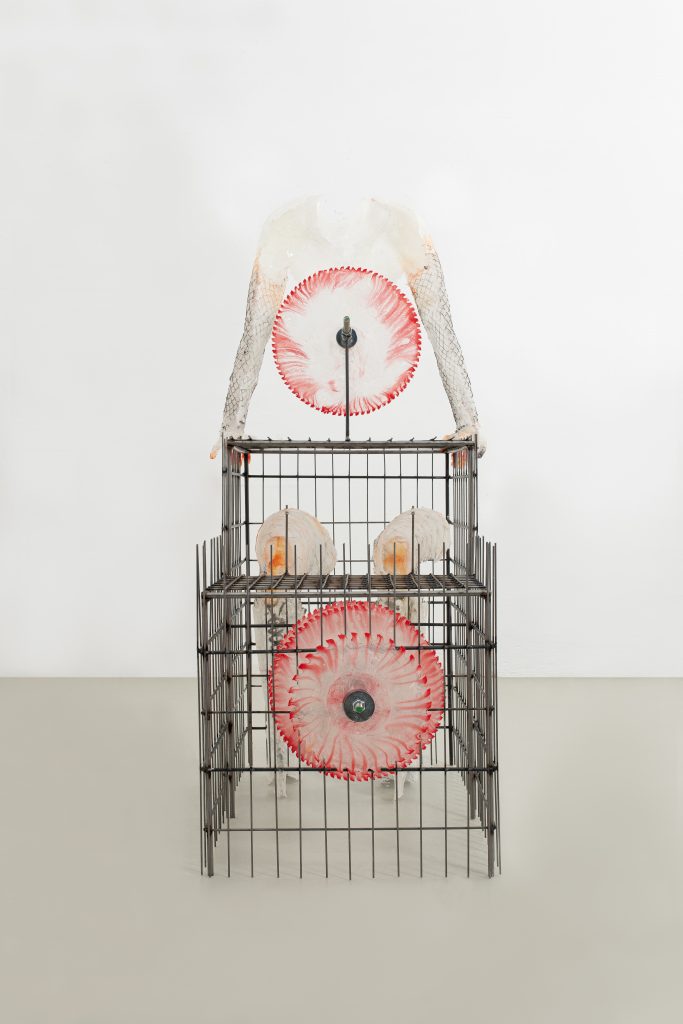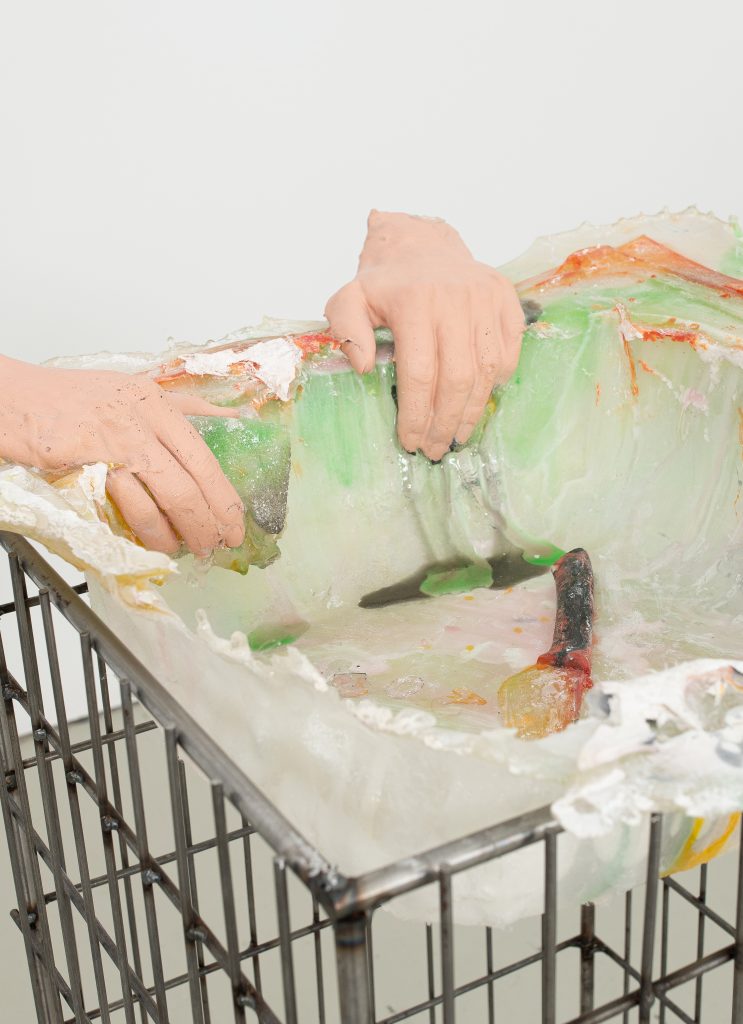On the heels of her Art Basel exhibition, Rebecca Ackroyd has new works in the window of Peres Project in Seoul. The British multidisciplinary artist talks to Stephenie Gee about her first Asia solo exhibition Fertile Ground and reflecting a sense of another time and place

As golden locks of hair permeate through the drain set on brushed rosy tiles that refer to fertility and blood, a sense of failed recognition and emotionally ambiguous charge is instilled. Which, punctuated by winding spirals – a repeated motif throughout her oeuvre – take you through an inner rite of passage deep into the recesses of the psyche. Meanwhile, discombobulated limbs of epoxy resin and fibreglass suspended above and within a metal cage with circular blades positioned probe the relationship between the body and architectural space, exploring the infrastructure of the subconscious.
This is Fertile Ground by Rebecca Ackroyd. “It comes from an initial idea I had about the relationship in the work between a sense of time passing – a ticking body clock – and an idea of connectivity through being earthed,” explains the artist. “All the works are connected by a red carpet that references the carpet we had in the house I grew up in throughout the stairs and hallways – the connectors between spaces – like veins between organs. The works allude to a capturing of movement and a spiral motif that repeats throughout the show that is a direct reference to time and also symbolises life, creation birth or rebirth.”
Also see: Interview: designer Pierre Charpin back to basics with Saint-Louis crystals
The impetus of this exhibition was your encounter with a building site in London – could you tell me more about this building site?
It’s not that the whole show is based around the one encounter, but more the idea of seeing the mass of pipes dug into the ground. It’s related to what we don’t see – the inner workings of say a mind, body or building.
Why did you decide to work with the materials that you did for this exhibition, like the chicken wire, for example? What is your process of material selection like?
It really depends on the work as each is different. For instance, in a previous work I appropriated a metal shutter by having my mother’s maiden name laser cut at the top and then painted pink. I wanted that piece to directly reflect the idea of a name being erased through marriage and the passing on of a male lineage while the female name gradually disappears. By emblazoning it onto a shop shutter, it is absorbed into a ubiquitous visual history – like shops that come and go on a high street – the lettering remains as a marker of a previous time. It was a literal pasting of personal history onto a readymade, a thing owned by all. The materials are very much determined by how I want the work to feel, for example, the cast works are made in translucent resin because I wanted them to have a fragile, ghost like quality.

There’s quite a big contrast between the paintings and the sculptures – they feel like independent bodies of work.
I’m interested in how the two processes differ – it’s possible for drawing to be free in a way that sculpture isn’t, as it requires more working out – it’s always the freedom I’m after. For a long time, the pastels occupied a more psychological space, in that I didn’t know where they come from and I couldn’t rationalise why I made them. To an extent, I feel that is one of the most exciting aspects of making art – the not knowing. I like to surprise myself. Because I work in numerous ways, different bodies of work represent different ideas. For instance, the cast sculptural works are often supposed to reflect an immediate lift from reality almost like a photo. I’m interested in the overlap between real and imagined spaces, drawing from past and present influences and employ many ways of making to create something layered and unpredictable
There are a lot of spirals in this exhibition – what does it represent and why did you decide to use the spiral pattern as punctuation for this exhibition?
The spiral is a literal reference to time, like a visual representation of time. But the spiral that I’m using is also very much referring to a sort of 1960s motif, so in my work I have an ongoing dialogue with the idea of psychoanalysis as a site for a personal excavation. It’s a way of bringing memory into the present in a way a person makes sense of their life and who they are at that moment by looking into their past.
Your titular sculpture Fertile Ground is quite haunting with the torso and legs separated and suspended above and within the metal cage.
The sculpture is called Fertile Ground, and again I use boots – these were my mother’s in the sixties, and they’re a recurring motif in my work. I like the idea of how using casts can route a sculpture at a particular time. For example, how using something from the past, like an item of clothing, shoe, object or something, and then bring it into the present by making a cast of it with me wearing it, gives it a kind of new meaning or kind of brings it into the present day, but also it looks back at a point in time.

In your previous works as well, the disconnected limb seems to be a reoccurring motif. What do they symbolise?
I use my own body or my friends and family to cast from. I like the idea that the process captures a fragment of the person at that particular time, it’s both very personal in one sense but also relates to a very ordinary idea of the ubiquity of a body – in that everyone has one. I like the idea that as the bodies I cast change – grow older, bigger or die – that these fragments will remain like a physical record – bones. I’m very much inspired by the ghosts of the past, both in terms of my family and in more of a general way.
A central tension in your works is the idea of past in the present and the fragmented character of memory – how is this presented in this exhibition?
The fragmentation refers to an attempt to physically entrap a thought or the remnant of a memory. I use casting as a way of making a snapshot, I very much see them as photographs that occur only once in that particular time. I often use pieces of clothing from my mum’s wardrobe – a recurring pair of boots of hers from the 70s are recast in different works – the clothes are of their time. There’s an idea of wistfulness for a simpler time that I’m interested in, how we romanticise the past. I try and bring elements of that into the work through the way I fragment things – a boot from the 60s next to a laptop from today. It all informs each other in the cross-pollination of time and stories creating a layering of content and imagery that references my personal history and a wider idea of visual culture through objects/fashion. In the show in Seoul, the boots in the sculpture are a recurring motif and were my mum’s in the 70s and they anchor the work in another time and relate to another person’s history.
We see a lot of body parts combined with architecture in your works – what does this relationship represent?
I’m interested in how architecture is imbued with sentimental value and memory, and how these ideas of space can become like hauntings of the past. I always loved the Mike Kelley work Educational Complex and how it revisits the site of teenage memory and excavates that uncomfortable and embarrassing past and examines it from the position of adulthood. In my work, I’m always looking for ways to change a space to reflect a sense of another time or place and bring up old memories or vague recollections. It’s a way of rethinking how the work is encountered.
Also see: 100 Takes: Ruby Law discovers inspiration from travelling























































